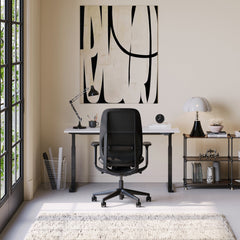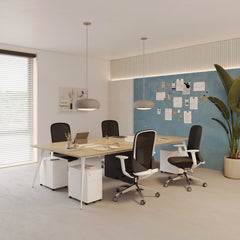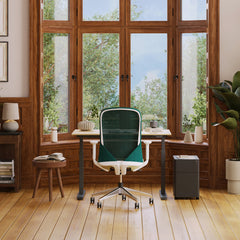Get 10% off your first order
Find the office furniture that’s designed to match your style, comfort, and needs perfectly. Subscribe
Beyond Desks and Chairs: How Cohesive Design Shapes Your Office Brand

Visit quiz page to see how we makes it easy to create an inspiring workplace

The real test of an office chair is not how it looks in a catalog but how naturally it supports different bodies through a full workday. Tall professionals often contend with shallow seats that cut into the thighs and backrests that end below the shoulders. Petite professionals frequently fight deep seats that push them forward, high armrests that elevate the shoulders, and seat heights that leave feet dangling. A chair that truly fits reduces strain, preserves circulation, and keeps the spine in a neutral, supported posture that sustains attention.
Evidence-based guidance emphasizes that fit matters for long-term comfort and safety. Authoritative resources such as the CDC guidance on ergonomic risk factors outline how posture, reach, and force interact with chair geometry to influence musculoskeletal health. The message is clear: a well-fitted chair is not a luxury, it is a foundation for healthy, productive work.

Tall bodies: backrests that stop short of the upper back, elevated knees when seats cannot lower enough, forward reach to desk surfaces, and pressure along the underside of the thighs when seat depth is too short.
Petite bodies: unsupported feet when minimum seat height is too high, reduced lumbar contact because the seat pan is too deep, shoulder elevation caused by tall armrests, and tension at the neck from looking up at a monitor.
Perfect fit usually results from several small adjustments working together. Seat height positions the hips and knees, seat depth positions the pelvis relative to the backrest, lumbar height supports the natural curve, armrests manage shoulder load, and tilt resistance allows movement while maintaining contact. When these variables are tuned to the user, the chair disappears and focus returns to the work.
Anthropometrics describes how body dimensions vary across populations. For chair fit, four measurements are especially influential: popliteal height, buttock–popliteal length, elbow height when seated, and shoulder height when seated. These measurements translate directly into seat height range, seat depth, armrest height range, and backrest or headrest height.
Seat depth should support most of the thigh without pressing into the back of the knees. Tall users typically need a deeper seat to distribute pressure evenly and keep the pelvis aligned. A model like the deep-seat high-back chair for tall users pairs an extended seat pan with a taller backrest, helping long limbs and longer torsos maintain neutral alignment without slouching.
Petite professionals benefit when the chair allows full backrest contact while the feet remain flat on the floor. The short seat pan office chair for petite frames illustrates how a compact seat and lower lumbar curve enable smaller bodies to sit back comfortably, preserving natural spinal curves and reducing forward scoot.
1. Sit fully back against the backrest. If there is more than a few fingers of space behind the knees, the seat is too deep.
2. Place feet flat on the floor. If heels lift or toes point downward, the seat height is too high.
3. Relax shoulders. If they elevate to reach the armrests, the armrests are set too high, too wide, or both.
Every useful adjustment has a purpose tied to biomechanics. Understanding why an adjustment exists helps users tune it correctly rather than turning knobs at random.
Seat height should align with popliteal height so the knees bend near ninety degrees and the feet rest firmly. Tall users may need the top of the height range to avoid knee elevation, while petite users require a minimum height that lets feet maintain full contact. If a desk is fixed and high, sometimes the seat must rise and a footrest completes the fit, preserving both keyboard reach and foot support.
A slight forward tilt can reduce pressure on the lower back for some tasks, while a level seat often works best for prolonged typing. Micro adjustments here change how the pelvis anchors to the backrest and can relieve tailbone pressure.
Recline unlocks movement, which reduces static load. Tilt tension should match body mass so the backrest supports movement without abrupt collapse. Tall bodies usually require a bit more resistance, while petite bodies benefit from a lighter, responsive setting that still maintains contact during small posture shifts.
Armrests should meet the elbows without lifting the shoulders and should allow the forearms to rest lightly. Adjustable width is especially valuable in shared environments. A versatile model like the mesh task chair with wide adjustability shows how range and precision help both large and small frames avoid shoulder and neck strain when moving between typing, mousing, and reading.
Headrests are effective when they support the base of the skull during recline, not when they push the head forward. Taller users often need a higher and deeper headrest setting to avoid chin tuck.
Materials influence heat, pressure distribution, and durability. Frames determine structural feel, lumbar systems influence contact point pressure, and textiles govern breathability.
Chairs that blend structured support with controlled flex help the spine maintain its natural S-curve as the user moves. The contoured shell chair with active lumbar demonstrates how sculpted geometry maintains contact through small shifts, encouraging balanced posture without rigid bracing.
Mesh provides airflow and tends to feel stable, a positive for taller bodies that benefit from firmness. Cushioning can attenuate pressure points for lighter users, which petite bodies may appreciate during extended sitting. Both can be supportive when paired with correct seat depth and lumbar positioning.
High-density foam retains shape better under repeated loading, while quality textiles resist pilling and heat buildup. Recyclable frames and modular components extend useful life by enabling repairs and part replacements rather than full chair turnover.
An ergonomic chair does its best work when aligned with a desk and monitor. If a fixed-height desk forces compromise, the user often ends up with either poor wrist angles or floating feet. Pairing seating with height range desks for posture alignment allows the chair to meet the user, and the desk to meet the chair, so the whole system supports neutral reach and vision.
Elbows at desk height or just below, which protects shoulders and wrists.
Eyes level with the top third of the display, which reduces neck extension or flexion.
Knees at roughly ninety degrees with full foot contact, which supports circulation.
Work patterns vary. A data analyst may prioritize neutral typing posture, while a designer spending time in review mode may value a relaxed recline with stable head and neck support. A configuration tool like the personalized workspace bundle builder helps match chair and desk options to specific task mixes, aesthetic preferences, and available space.
Wrists bent upward while typing suggests the desk is too high relative to the chair.
Shoulders creeping toward the ears suggests armrests or desk height are excessive.
Pressure behind the knees suggests the seat is too deep or too high.
| Chair Variable | Tall Users, Practical Range | Petite Users, Practical Range | Why It Matters |
|---|---|---|---|
| Seat Height | Approximately 19 to 24 in | Approximately 15 to 19 in | Aligns hips and knees to reduce thigh pressure and foot strain |
| Seat Depth | Approximately 19 to 22 in | Approximately 15 to 18 in | Preserves backrest contact without compressing the knees |
| Backrest Height | Upper back to shoulder coverage | Mid to upper back coverage | Maintains thoracic support during upright and reclined tasks |
| Armrest Width | Adjustable, wider starting point | Adjustable, narrower starting point | Centers the elbows under the shoulders to prevent elevation |
| Lumbar Height | Slightly higher curve placement | Lower curve placement | Matches lumbar apex to natural spinal curve |
Use these ranges as a guide. The most comfortable chair will also offer adjustment span beyond these targets, since bodies vary.

Prioritize range over a single number, since adjustability determines adaptability.
Look for seat depth adjustability if multiple users will share the same chair.
Check minimum seat height first for petite fit and maximum height first for tall fit.
Confirm that lumbar height or depth can be tuned, not just fixed.
Small, often overlooked components influence the daily feel of a chair and can make a measurable difference for both tall and petite users.
A rounded waterfall edge reduces pressure behind the knees during long sessions. This is especially helpful for petite users who sit toward the front of a deeper seat and for tall users who need generous thigh support without constriction.
Taller users benefit from a slightly taller cylinder that still permits stable foot contact. Petite users may prefer a cylinder that reaches a lower minimum and casters that roll smoothly without requiring extra ankle push. On carpets, larger casters reduce effort, while on hard floors, softer wheels control speed and noise.
Arm pads that swivel and slide can bring support directly under the forearms during mouse-heavy tasks. Petite users generally do better when armrests can come closer to the torso without flaring outward. Tall users often prefer slightly higher and wider settings that align with broader shoulders.
Even the best chair cannot compensate for unchanging posture. Micro-movement protects tissues and refreshes focus.
Shift between upright typing posture and a relaxed recline for review tasks.
Stand briefly during calls or when reading, especially after long typing intervals.
Reset the pelvis by sitting fully back to re-establish lumbar contact after reaching forward.
If the desk requires a higher chair position, a compact footrest restores foot contact and reduces pressure behind the knees. The goal is stable grounding without plantar flexion, which keeps the ankles and knees comfortable during long sessions.
Clear criteria help convert measurements and preferences into a short list of well-suited chairs.
1. Minimum backrest height that reaches the shoulder blades or higher.
2. Seat depth at the deeper end of the range, ideally with adjustability.
3. Strong tilt mechanism with adequate tension range to support recline.
4. Armrests that raise high enough to meet the elbows without shoulder slump.
5. Stable base with a cylinder that reaches a comfortable typing height without forcing knee elevation.
A deep-seat model like the deep-seat high-back chair for tall users matches these priorities with generous depth and upper-back coverage for large frames.
1. Minimum seat height that allows feet flat on the floor without a footrest, when possible.
2. Short seat pan or seat depth adjustment that keeps two to three fingers of clearance behind the knees.
3. Lower lumbar curve that meets the natural spine without pushing the upper back forward.
4. Armrests that can drop low and narrow enough to stop shoulder elevation.
5. A mechanism that reclines smoothly with lighter tension.
A compact model such as the short seat pan office chair for petite frames aligns with these goals, helping smaller bodies maintain backrest contact and neutral shoulders.
Fit gets users in the chair. Feel and aesthetics keep them using it. A cohesive lineup, such as the ergonomic seating lineup at Urbanica, blends contouring, breathable materials, and restrained forms that suit modern work settings without calling attention to themselves.
In compact spaces, prioritize chairs that preserve knee clearance under the desk, maintain lumbar contact at shallow seat depths, and allow armrests to tuck beneath the work surface. The aim is to create free movement paths without sacrificing adjustability.
Neutral textiles, soft matte frames, and breathable weaves reduce visual noise and heat accumulation. Calm visuals often translate into calm posture, making it easier to maintain consistent work rhythms.
Not all tasks require the same posture. Align chair settings with what you are doing to maintain energy without strain.
Upright torso with the backrest slightly engaged.
Armrests set to support elbows lightly at desk height.
Feet grounded, knees near ninety degrees.
Slight recline with the head supported, screen pulled closer or zoom increased.
Tilt tension set to allow small movements without losing back contact.
Seat height adjusted for eye-level contact with colleagues.
Armrests lowered or pivoted away to enable free shoulder movement.
Designing for the full range of human proportions is no longer an optional detail in office planning. It has become a measurable standard of occupational health and inclusivity. When employers and designers choose seating that serves both tall and petite bodies, they signal respect for physical diversity and create conditions where everyone can perform comfortably for sustained periods.
Workplaces that prioritize fit and adjustability send a broader cultural message about well-being. Chairs that adapt to each user reduce absenteeism related to musculoskeletal strain, but they also reinforce equity by ensuring that no one must work in discomfort because of their body size. A balanced ergonomic program considers every worker’s reach, posture, and preferred mobility throughout the day.
Ergonomic diversity is not just biological; it is also geographic. Body dimension averages differ between regions, which means furniture suited to one market may not match the anthropometrics of another. Organizations expanding globally can gain a competitive advantage by specifying adjustable ranges that meet local population data rather than importing a single standard worldwide. This sensitivity improves fit and demonstrates cultural awareness that supports international teams.
Inclusive seating design overlaps with accessibility standards in more ways than many realize. Adjustable controls that require minimal force, clear labeling of levers, and stable casters that roll smoothly on multiple surfaces contribute to safer environments for a wider range of users. This intersection of ergonomics and accessibility makes the office a more supportive place for everyone, including individuals with mobility differences or temporary physical limitations.
Longevity in office comfort depends on materials, maintenance, and adjustability that endure over time. Selecting chairs with replaceable parts and modular upholstery reduces waste while extending usability. Long-term sustainability and physical health reinforce each other: a durable chair that maintains support helps prevent posture decline, and reduced replacement cycles benefit both budget and environment.
As workplaces become more data-informed, the next stage of ergonomics will focus on feedback rather than automation. Adjustable chairs paired with self-assessment tools can guide users to correct settings without overcomplicating the design. The principle remains simple: empower the user with meaningful control, clear guidance, and reliable materials. This approach keeps ergonomics human-centered rather than technology-dependent.
When comfort and inclusivity shape furniture decisions, productivity and morale follow naturally. A well-fitted chair encourages physical confidence, steadier focus, and genuine engagement with work. These outcomes reinforce why anthropometric consideration belongs at the core of workplace design strategy, not as an afterthought.
Inclusive ergonomics represents a quiet revolution in professional well-being, one where every individual, regardless of height or frame, can take their seat and know it was designed with them in mind.

Beyond Desks and Chairs: How Cohesive Design Shapes Your Office Brand

The Silent Energy Drain: Designing Tables and Chairs That Fight Work Fatigue

The Performance Equation: Unlocking Employee Potential with Ergonomic Design
Get 10% off your first order
Find the office furniture that’s designed to match your style, comfort, and needs perfectly. Subscribe
Leave a comment